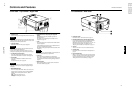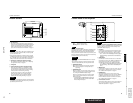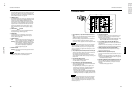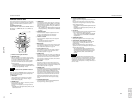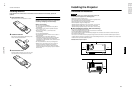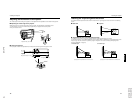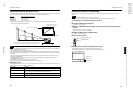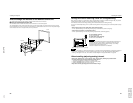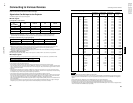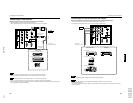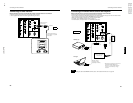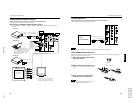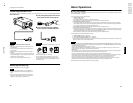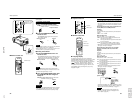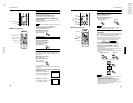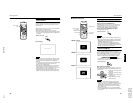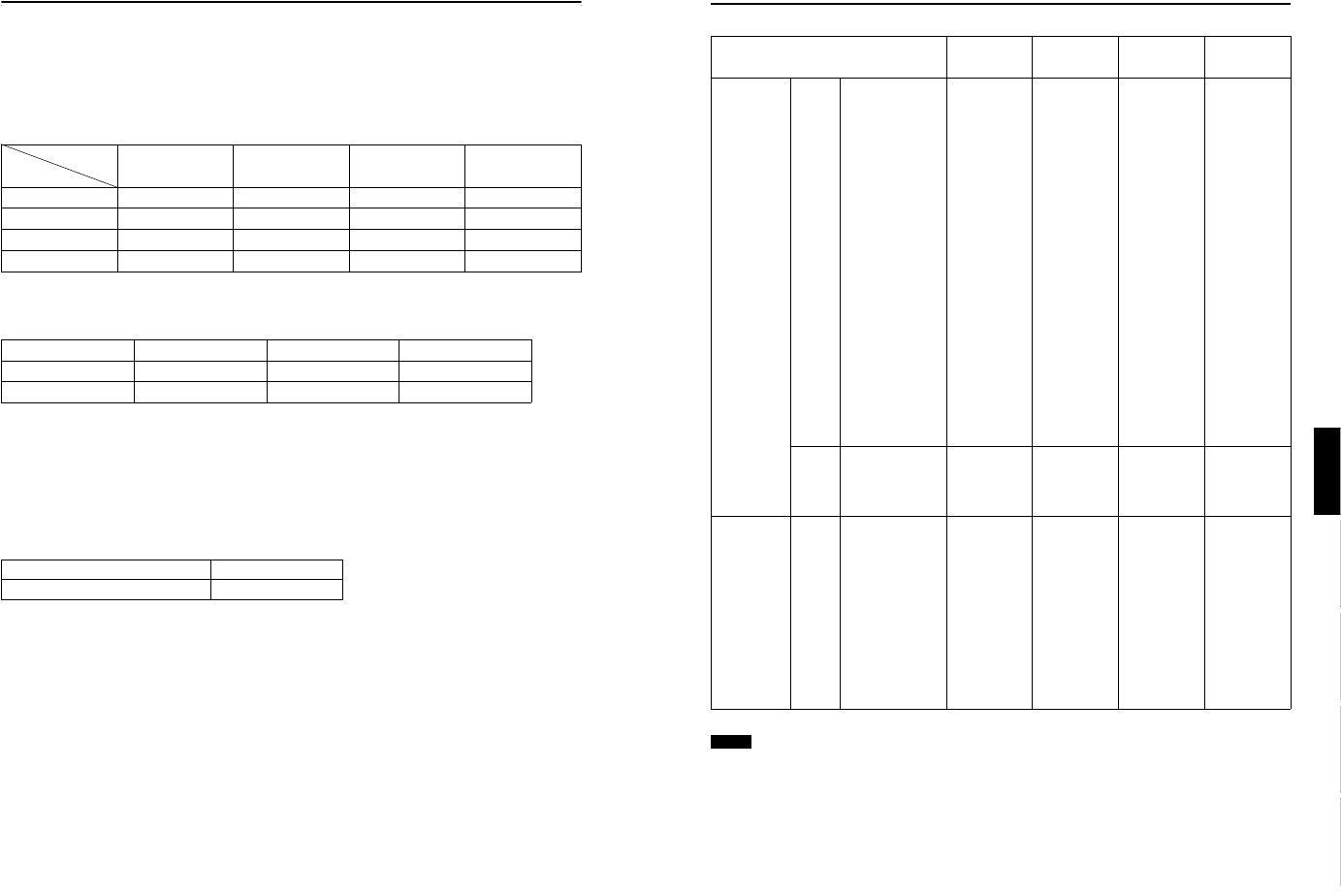
DLA-G150CLU
DLA-G150CLE
1-12
No.51931
23
Connecting to Various Devices
ENGLISHDEUTSHFRANÇAISITALIANOESPAÑOL
■ Allowable input signals
* A signal that can be input by DVI (V-sync 85Hz is not supported.)
Notes
• The resolution for the input signals is listed in the above table.
• Even signals in the frequency range that can be input may not be displayed normally depending on the type of the signal.
• When a signal other than listed above is input, the image could be partially erased or an unneeded fold-over image could
appear.
• Some signals other than listed above can be displayed. But they may require adjustment.
• Even some of the signals listed above may require adjustment depending on the video board used.
• Composite sync (C
S
) and G on Sync signals cannot be handled depending on the devices connected.
• The VGA signal of the PC system could be displayed in 480p mode of the VIDEO system. (In this case, the projector enters
video menu mode when the MENU button is pressed.)
Signal
Horizontal res-
olution
Hor [Pixels]
Vertical resolu-
tion
Ver [Lines]
Horizontal fre-
quency
H [kHz]
Vertical fre-
quency
V [Hz]
PC system PC98 VESA350 640 350 37.86 84.13
PC/AT PC98 640 400 24.83 56.42
DOS/V VGA 60Hz* 640 480 31.47 59.94
DVI* VGA 72Hz* 640 480 37.86 72.81
VGA 75Hz* 640 480 37.50 75.00
VGA 85Hz* 640 480 43.27 85.01
SVGA 56Hz* 800 600 35.16 56.25
SVGA 60Hz* 800 600 37.88 60.32
SVGA 72Hz* 800 600 48.08 72.19
SVGA 75Hz* 800 600 46.88 75.00
SVGA 85Hz* 800 600 53.67 85.06
XGA 43Hz* 1024 768/2 35.52 43.48
XGA 60Hz* 1024 768 48.36 60.00
XGA 70Hz* 1024 768 56.48 70.07
XGA 75Hz* 1024 768 60.02 75.03
XGA 85Hz* 1024 768 68.68 85.00
SXGA 43Hz* 1280 1024/2 46.43 43.44
SXGA 60Hz* 1280 1024 63.98 60.02
SXGA 75Hz* 1280 1024 79.98 75.03
SXGA 85Hz* 1280 1024 91.15 85.02
UXGA 60Hz 1600 1200 75.00 60.00
Mac MAC13 640 480 35.00 66.67
MAC16 832 624 49.73 74.55
MAC19 1024 768 60.24 74.93
MAC21 1152 870 68.68 75.06
Video system Video HDTV (1035i) 60Hz 33.75 60.00
HDTV (1035i) 59Hz 33.72 59.94
480p 720 483 31.47 59.94
720p 60Hz 1280 720 45.00 60.00
720p 59Hz 1280 720 44.96 59.94
1080i 60Hz 1920 1080/2 33.75 60.00
1080i 59Hz 1920 1080/2 33.72 59.94
1080 24sF 1920 1080 27.00 24.00
NTSC 15.734 60
PAL 15.625 50
SECAM 15.625 50
22
Connecting to Various Devices
Before connection, be sure to turn off the projector and connected devices.
Read the manual which comes with each device thoroughly.
Signals that Can Be Input to the Projector
The following signals can be input to the projector:
■ Video signals
(1) Response to color systems
*1:Responds if Y/C output is available.
*2:Signifies that component signals (“Y, P
B
, P
R
” / “Y, B-Y, R-Y” / “G, B, R, H/C
S
, V”) conform to the signal timing
(synchronization and video period) of each color system. The color systems are used for convenience only.
(2)
Response to double density (*3), high-vision signals
*3:Signals whose density of scanning lines/field is twice as high.
*4:Responds to signals whose horizontal scanning frequency is 31.5 kHz. NTSC can be made twice as dense by a line
doubler (separately available: recommended article). Also, possible to respond to fully-specified, decoded
wide-clear-vision signal and decoded 525P progressive signal.
*5:Responds to signals whose horizontal scanning frequency is 33.5 kHz. PAL can be made twice as dense by a line doubler
(separately available: recommended article).
(3) Response to DTV-format signals
DTV-format signals (480i, 480p, 720p, 1080i) can be input to the Y, P
B
/B-Y, P
R
/R-Y, G, B, R, H/C
S
, V input terminal.
■ Computer signals
Signals with the following scanning frequencies can be input to the PC 1 or PC 2 (G, B, R, H/C
S
, V) and DVI terminals.
Be sure that the computer to be used suffices the following conditions:
• The computer has the video signal output port.
Be sure that the computer has the video signal output port by reading the instruction book of the computer.
The video signal output port is generally called as “RGB port”, “monitor port”, or “video port”. If the computer-monitor hybrid
type or note type is used, it may need to prepare for an external output port. Also, there will be the type to which an external
output port cannot be installed.
• DVI input
During DVI input, depending on the computer settings, there may be no signal input or an error may occur (blue screen).
If this happens, turn off the power to both the projector and the computer, and then turn the projector back on before turning
the computer on again. Then correctly set the computer's graphic board.
• The resolution and the scanning frequencies are within the range specified in the table on page 23.
Be sure that the resolution and the scanning frequencies of the video signal are within the range. A video signal out of range
cannot be used. (Even signals out of the range could be projected. However, it may not sharp enough. On the other hand,
even some of the signals within the range may require adjustment depending on the video board used.)
When a signal other than listed in the table on page 23 is input, the image could be partially erased or an unneeded fold-over
image could appear.
Even signals in the frequency range that can be input may not be displayed normally depending on the type of the signal.
Composite sync (C
S
) and G on Sync signals cannot be handled depending on the devices connected.
Color systems
Input terminal
NTSC NTSC4.43 PAL SECAM
VIDEO ‡‡‡‡
Y/C ‡
‡*
1
‡ - - - - -
Y, P
B
/B-Y, P
R
/R-Y ‡*
2
‡*
2
‡*
2
‡*
2
G, B, R, H/C
S
, V ‡*
2
‡*
2
‡*
2
‡*
2
Input terminal
NTSC*
4
NTSC*
5
High-vision signal
Y, P
B
/B-Y, P
R
/R-Y
‡‡‡
G, B, R, H/C
S
, V
‡‡‡
Horizontal scanning frequency 15kHz - 105kHz
Vertical scanning frequency 50Hz - 100Hz



